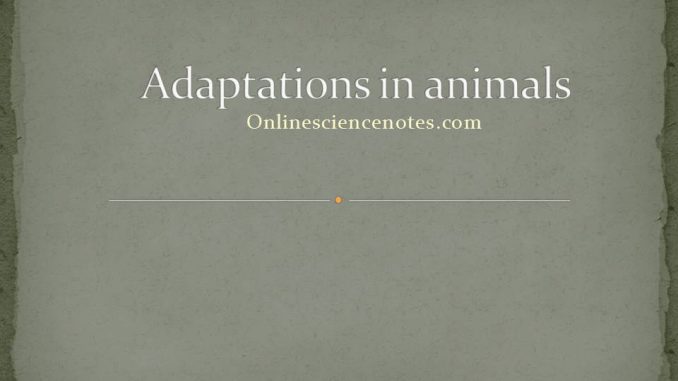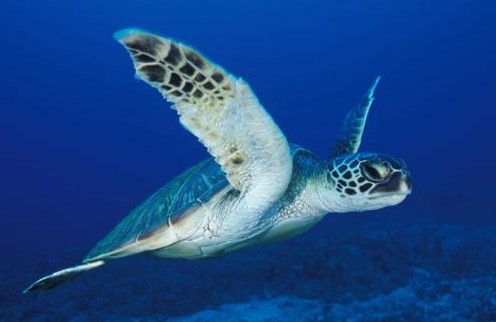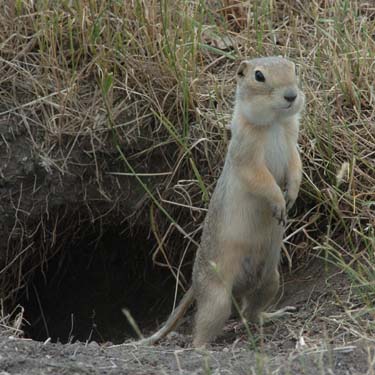
Aquatic adaptations in animals:
a) Aquatic adaptations in fish
- They have streamlined body which offers least resistance during locomotion through water.
- Fins help in locomotion. Pectoral fins act as balancers and the caudal fin (tail fin) helps in changing the direction.
- They breathe through gills which are well adapted for gaseous exchange underwater.
- Bony fish have in their body cavity a long air filled swim bladder or air bladder that makes their body buoyant (help them float when they stop swimming).
- The entire body is covered with waterproof scales with mucous coating on the surface.

b) Other aquatic animals:
- They also have a streamlined body with reduced neck.
- The limbs have become webbed (frogs, ducks, turtles) or modified to form paddles or flippers (whale, penguins and dolphins).
- Aquatic mammals lack hairs and skin glands (sweat and oil glands).
- They all are air breathers and have muscular flaps in their nostrils to keep them closed when the animals are diving.
- e.g. whales, dolphins, seals, penguins, turtles, water snakes etc.

Terrestrial adaptations in animals:
- The terrestrial adaptations are far more varied than the aquatic habitat. Animals living on land show the following types of adaptations:
a) Cursorial adaptations:
- They inhabit open spaces on land and are adapted for running on hard ground.
- The body is streamlined that offers least resistance during swift movement.
- The limbs are elongated with reduced digits. They move on their digits (fingers and toes), i.e. digitigrade locomotion.
- The neck is long and eyes are raised high up on the head with keen vision.
- e.g. ostriches, kangaroo, hares, tigers, leopards, deer etc.

b) Fossorial adaptations:
- They are adapted for burrowing mode of life.
- Body is either cylindrical or spindle shaped to offer least resistance during burrowing.
- The head tapers anteriorly to form a snout.
- The forelimbs are short and have powerful claws for digging.
- They undergo hibernation in winter due to scarcity of food like insects and vegetation.
- The tail is short or vestigial.
- e.g. moles, desert snakes, hares, hedgehogs etc.

c) Arboreal or scansorial adaptations:
- They are adapted for climbing on trees or other objects.
- The pectoral girdle (shoulder joint) is strong with well-developed clavicles and scapula.
- Forelimbs become elongated for swinging on trees.
- Hind limbs may be prehensile (i.e. grasping) with more or less opposable digits (e.g. primates and sloths) or non-opposable with well-developed claws (e.g. cats and squirrels).
- Adhesive pads are present on the tips of digit or on the soles of feet help to hold on the wall or branches of trees (e.g. geckoes, tree frogs, wall lizards).
- They move on their whole foot (i.e. plantigrade locomotion).
- The tail may be prehensile (e.g. chameleon, monkeys etc.) for grasping the branches of trees.
- e.g. chameleons, squirrels, marsupials, lemurs, sloths primates etc.

d) Aerial or Volant adaptations:
- They have a boat-shaped body which offers little resistance during flight.
- The forelimbs in birds are modified into wings which have large surface area provided by feathers.
- In bats, forelimbs are modified into patagium (fold of skin) which is supported by all the digits except the first and extends along the sides of the body up to the tail.
- In insects, wings are thin membranous folds of their exoskeleton.
- In birds, bones are hollow and spongy to reduce body weight.
- They have strong flight muscles for flapping their wings up and down.
- Sense organs (especially eyes) are well-developed.
- In birds, the jaws are modified into beaks.
- e.g. birds, bats, insects etc.

e) Desert adaptations:
- Desert animals depend on succulent plants (e.g. rabbits) or on the blood of the prey (e.g. carnivores) for the supply of water.
- The desert lizard has hygroscopic skin that absorbs water from the atmosphere just like blotting paper.
- Their skin is thick to avoid perspiration in the day time to prevent the loss of water.
- Camels have large, flat sole to properly walk and run on sand without sinking.
- Camels have humps on their back to store food and fats.
- Camels store sufficient water in special water storing cells.
- Their eyes, ears and nostrils are well protected from the blowing sand particles.
- Some animals escape the extremes of heat and cold by burrowing into the sand and become active in the morning and evening.
- e.g. camels, kangaroo rat, snakes, rabbits, lizards etc.

f) Adaptations to cave life:
- They are nocturnal (active at night).
- There is loss of pigmentation in their bodies.
- In the absence of light in the caves, the eyes have become reduced or functionless.
- The tactile and olfactory organs are well developed.
- In bats, the sense of echolocation is highly evolved which enables them to avoid obstacle and catch insects during flight in the darkness.
- e.g. bats

Keep Up the hard work Sir!Your website is very informative!